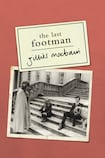
Did Dublin bus conductors once greet young women with a kiss when they stepped on board their buses? They did in 1963, according to Gillies Macbain whose memoir, The Last Footman, is a very funny, often bizarre account of life above and below stairs in some of Ireland’s great houses in the 1960s and 1970s.
Scottish-born Gillies Macbain, who lives in Ireland to this day, is a real-life Darcy Dancer who crams a staggering number of adventures into the dozen years covered by the book.
The narrative gallops along, entirely written in lower case and none the worse for it. Macbain pub crawls around Dublin with Garech Browne, stars in a movie and becomes a shop steward in a factory, before finding an heiress, but that’s all to come.
Just off the bus, he pawns his father’s cufflinks in Louis Wine’s shop on Grafton Street and is eventually forced to sign up with Miss Synnott’s Domestic Employment Agency of Middle Abbey Street, which provided staff to “the fading world of the big houses of Anglo-Ireland”. Macbain has no trouble securing work as a footman and later a butler, but his charm and good looks frequently get him into hot water.
Buckingham Palace
An early employer – a titled gent with an estate in Wicklow – is so taken with Macbain that he offers to put in a word for him for a job at Buckingham Palace, but Macbain dirties his bib by blathering to a journalist friend about life in the big house and the offer is quietly withdrawn.
Nevertheless the same gentleman secures him a position with Miss Rose Talbot of Malahide Castle, where he makes an enormous gaffe by listening in to the dinner conversation and worse, supplies one of the guests – an English politician – with a word he’s struggling to find. “Oxymoron,” Macbain says quietly to him as he serves a dollop of mashed potato.
A freezing silence ensues. But he loves working at Malahide where the diningroom is hung with portraits of Talbots down the ages and where “over 100 pairs of painted eyes followed you around the room”.
Befriended by an incipient alcoholic called Sketchley, he shares rooms with him for a while under the eaves of a knitting factory in Parliament Street. The two swagger daily into Trinity College to take hot baths in the bathhouse donated by the Guinness family.
Educated in England, and mysteriously unencumbered by family, Macbain converts to Catholicism in order to meet girls. Christmas 1966 finds him in Connemara in the company of a band of posh boys who run up credit in pubs and shoot a swan for their Christmas dinner. Having failed to pluck and cook the bird, they are fed at a local hotel by the owner, Bubbles, who encourages her daughter Claudia to walk out with Macbain. He is 24 and she is 15.
Inheritance
Though often down to his last few shillings, Macbain is not penniless: an inheritance of £5,000 allows him to buy a Georgian pile in Co Monaghan called Laragh House.
He spends his last £50 on an Irish wolfhound he calls Murphy and it is this dog that features on the cover of the book, being admired by Mick Jagger and Marianne Faithfull, on the steps of Castletown House. While it looks as if they are all chums together is just a moment in time as Jagger and Faithfull were taking their leave of the house while Macbain was arriving to take up a job as caretaker.
The picture perfectly illustrates his own uneasy position which he perfectly describes: “I realise that all of my stories are essentially the one story – a story of gate-crashing across the frontier between the servants and the served.”
Life at Castletown is bohemian and wonderful with Mariga Guinness – who, with her husband, Desmond, had saved the house from destruction – painting the empty rooms in vivid colours and inspiring a band of student volunteers to help with the restoration.
A cook is needed and Macbain suggests Claudia from Connemara, it being the summer holidays. Bubbles duly delivers her daughter to Castletown and the pair consummate their relationship as soon as the necessary condoms arrive in the post from England. In September she returns to school for her final year and they continue to see each on and off but eventually she drifts out of his reach.
Macbain endures a damp existence in Monaghan where his house is cold and his lands are overrun by goats. Unsuited to farming, he flits from job to job: one moment he is working at creamery analysing milk, the next in a towel factory where he is made shop steward.
In between, he takes up stints as a butler and then as a waiter in a new restaurant, Snaffles. Along the way he falls for a flame-haired fashion designer he calls Patra Keane, but who sounds awfully like the late Pat Crowley, a gifted couturier who died in 2013.
Proposes to an heiress
It all seems a bit hopeless until he borrows a suit and proposes to an heiress who says “yes”. In jig time they are married and doing up a house in Ely Place that overlooks an orchard where the RHA Gallery now stands.
Finally firmly above stairs, he breakfasts in the Shelbourne and buys a dairy farm in Co Wicklow which leaves Laragh, the damp Monaghan pile, surplus to requirements. He sells it to a dubious type in a Mercedes who moves in before the deal is complete and introduces terrible new carpets. It’s the carpets that really hurt and Mac Bain retaliates by setting fire to the house. Or did he?
It’s hard to disentangle fact from fiction or wishful thinking in this sometimes charming, sometimes sinister narrative. The story ends sometime in 1974 but there would seem plenty more to come and I for one want to know what happens next.














